Deschambault-Grondines
Deschambault-Grondines is a municipality of about 2,200 inhabitants in the Canadian province of Quebec, located in Portneuf Regional County Municipality. The municipality was incorporated in 2002 by the merger of the formerly independent villages of Deschambault and Grondines. [4]
Deschambault-Grondines | |
|---|---|
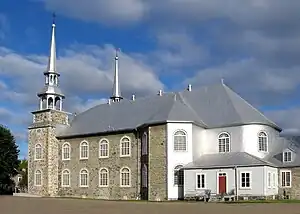 Saint-Joseph de Deschambault Church | |
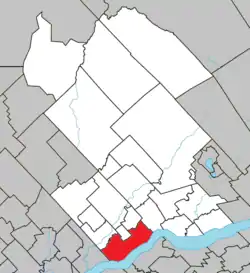 Location within Portneuf RCM | |
 Deschambault-Grondines Location in central Quebec | |
| Coordinates: 46°39′N 71°56′W[1] | |
| Country | Canada |
| Province | Quebec |
| Region | Capitale-Nationale |
| RCM | Portneuf |
| Constituted | 27 February 2002 |
| Government | |
| • Mayor | Patrick Bouillé |
| • Federal riding | Portneuf—Jacques-Cartier |
| • Prov. riding | Portneuf |
| Area | |
| • Total | 152.00 km2 (58.69 sq mi) |
| • Land | 124.02 km2 (47.88 sq mi) |
| Population (2021)[3] | |
| • Total | 2,235 |
| • Density | 17.0/km2 (44/sq mi) |
| • Pop 2016–2021 | |
| • Dwellings | 1,169 |
| Time zone | UTC−5 (EST) |
| • Summer (DST) | UTC−4 (EDT) |
| Postal code(s) | |
| Area code(s) | 418 and 581 |
| Highways | |
| Website | www |
The name Grondines was named by Samuel de Champlain[5] himself. "Grondines" is from the French verb "gronder", meaning to rumble or roar. In 1674, The Grondines windmill was built and is the oldest windmill in Québec.
The windmill was first a flour mill, and then a lighthouse. In 1842 the church Saint-Charles-Borromée was built in Grondines. In 2006 the local Fromagerie des Grondines was built, it is an organic cheese farm open to the public.
Some of the famous people who lived here include filmmaker Denys Arcand, who was born in Deschambault.
The patron saint of Deschambault-Grondines is Saint Joseph.[6]
History
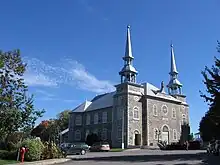
. . . At one time, Deschambault was said to have "a pilot every two houses." Very early on "the taste for the sea" developed there, because the St. Lawrence has long been the only way to access the village. "Everything was happening on the river !" says Father Jacques Paquin, coordinator of the Deschambault Navigators Committee." Even after the opening of the Chemin du Roy, a route considered difficult, the seaway continued to be used more than the land route. Deschambault, a village of sailors, Le Soleil. Translated from French.[7]
Seigneurie des Grondines
The 'seigneurie des Grondines' was one of the oldest lordship in the province of Quebec, and was initially granted in 1637 by the Company of New France to Duchess Marie-Madeleine de Vignerot de Pontcourlay, Dame d'atours of Marie de' Medici, and niece of Cardinal Richelieu, chief minister of Louis XIV.[8]
The estate covered a land area of around 90 square miles or nearly 60,000 acres.[9][10] In 1646, the Governor of New-France at the time, Charles Jacques Huault de Montmagny, gave the concession to the nuns hospitallers, administrators of Hôtel-Dieu de Québec, and thereafter, it was resold in 1683 to Lord Jacques Aubert.[9] Being the father-in-law of Louis Hamelin, the next lord of Grondines, the lordship passed to the Hamelin family afterwards, and was transmitted to their descendants until 1797, following the British Conquest.[8][9] In 1698, comte Louis de Buade of Château Frontenac award them concessions, extending their lordship with additional islands and isles.[11] This family was one of the eight seigneurial dynasties that lived permanently on their estate for six generations.[12]
Over time, the Hamelins married members of the French-Canadian nobility. The families were the Couillard de l'Espinay, the Denys de la Ronde, partners of Charles Aubert de La Chesnaye, the Fleury d'Eschambault, the Gaultier de Varennes, the Lorimier de la Rivière, the Chavigny de la Chevrotière, and their in-laws included the Barons Le Moyne de Longueuil, the Pézard de Champlain, and the Boucher de Montarville.[13][14][15][16]
A member of this family was also recognized as noble by the Sovereign Council of New France of Louis XIV in 1654, and would join the French-Canadian nobility, being the lord and commander Jacques-François Hamelin de Bourgchemin et de l'Hermitière, a descendant of Jacques Hamelin, bishop of Tulle.[17][18][19][20] In 1766, a member of the Hamelin de Chavigny also appeared in documents of the Canadian nobility, where they asked the king to keep in power the current Governor of Quebec James Murray, with the hope of being less penalized by the injustices they had to suffer after the British conquest.[21]
The signatories, including A. Hamelin, were Luc de la Corne, François-Joseph Cugnet, Aubert de Gaspé, Antoine Juchereau Duchesnay, and a few others.[21] The last lord of Grondines was Senator David Edward Price in 1871, a member of the influential Price family.[9]
Geography
Geology

DESCRIPTION OF THE AREA
« . . . The part of the Grondines map-area underlain by Paleozoic rocks (approximately two-thirds of the whole) is a nearly featureless plain rising in the north and west to 250 feet above sea level, and dropping to tide water level along the Saint-Laurent. » Ministry of Energy and Natural Resources (Quebec), Grondines area, Geological report.[22]
Flora
« . . . The Grondines and Sainte-Anne-de-la-Pérade swamp is one of the last, large, treed swamps on the river. It extends along seven kilometres of shoreline in the St. Lawrence River’s freshwater estuary.
The swamp shelters several at-risk species, including plants that are endemic to the freshwater estuary. It is a rare biodiversity hot spot on a global scale, according to the Atlas de la biodiversité du Québec (Quebec biodiversity atlas). » The Grondines and Sainte-Anne-de-la-Pérade Swamp, A unique ecosystem [23]
- Habitats: swamp, tidal flats, roadsides, etc.
 Sanguinaria canadensis L. — Bloodroot
Sanguinaria canadensis L. — Bloodroot Physocarpus opulifolius (L.) Maxim. — Nine-bark
Physocarpus opulifolius (L.) Maxim. — Nine-bark Hesperis matronalis L. — Dame's rocket
Hesperis matronalis L. — Dame's rocket Malva moschata L. — Musk mallow
Malva moschata L. — Musk mallow Centaurea nigra L. ― Black knapweed
Centaurea nigra L. ― Black knapweed Impatiens glandulifera Royle. ― Giant Impatiens
Impatiens glandulifera Royle. ― Giant Impatiens
Climate
| Climate data for Deschambault-Grondines | |||||||||||||
|---|---|---|---|---|---|---|---|---|---|---|---|---|---|
| Month | Jan | Feb | Mar | Apr | May | Jun | Jul | Aug | Sep | Oct | Nov | Dec | Year |
| Record high °C (°F) | 9.0 (48.2) |
9.0 (48.2) |
16.0 (60.8) |
30.5 (86.9) |
33.0 (91.4) |
34.5 (94.1) |
34.0 (93.2) |
34.4 (93.9) |
33.0 (91.4) |
26.0 (78.8) |
21.0 (69.8) |
13.0 (55.4) |
34.5 (94.1) |
| Average high °C (°F) | −7.3 (18.9) |
−5.0 (23.0) |
0.8 (33.4) |
9.1 (48.4) |
17.4 (63.3) |
22.8 (73.0) |
25.1 (77.2) |
24.1 (75.4) |
19.1 (66.4) |
11.5 (52.7) |
4.0 (39.2) |
−3.4 (25.9) |
9.9 (49.8) |
| Daily mean °C (°F) | −12.1 (10.2) |
−10.3 (13.5) |
−4.1 (24.6) |
4.3 (39.7) |
11.7 (53.1) |
16.9 (62.4) |
19.5 (67.1) |
18.6 (65.5) |
13.8 (56.8) |
7.2 (45.0) |
0.6 (33.1) |
−7.4 (18.7) |
4.9 (40.8) |
| Average low °C (°F) | −17 (1) |
−15.5 (4.1) |
−9.0 (15.8) |
−0.5 (31.1) |
5.9 (42.6) |
11.0 (51.8) |
13.9 (57.0) |
13.0 (55.4) |
8.5 (47.3) |
2.9 (37.2) |
−2.8 (27.0) |
−11.4 (11.5) |
−0.1 (31.8) |
| Record low °C (°F) | −38.5 (−37.3) |
−35 (−31) |
−31.5 (−24.7) |
−17.0 (1.4) |
−4.0 (24.8) |
−1.0 (30.2) |
3.0 (37.4) |
1.1 (34.0) |
−5.5 (22.1) |
−7.0 (19.4) |
−24.0 (−11.2) |
−35.0 (−31.0) |
−38.5 (−37.3) |
| Average precipitation mm (inches) | 77.0 (3.03) |
70.0 (2.76) |
69.1 (2.72) |
85.4 (3.36) |
100.5 (3.96) |
110.4 (4.35) |
125.5 (4.94) |
108.5 (4.27) |
116.5 (4.59) |
107.8 (4.24) |
95.6 (3.76) |
91.9 (3.62) |
1,158.1 (45.59) |
| Average rainfall mm (inches) | 26.3 (1.04) |
19.9 (0.78) |
31.5 (1.24) |
76.6 (3.02) |
99.7 (3.93) |
110.4 (4.35) |
125.5 (4.94) |
108.5 (4.27) |
116.5 (4.59) |
107.0 (4.21) |
74.1 (2.92) |
36.9 (1.45) |
932.8 (36.72) |
| Average snowfall cm (inches) | 50.7 (20.0) |
50.1 (19.7) |
37.6 (14.8) |
9.0 (3.5) |
0.8 (0.3) |
0.0 (0.0) |
0.0 (0.0) |
0.0 (0.0) |
0.0 (0.0) |
0.8 (0.3) |
21.5 (8.5) |
55.0 (21.7) |
225.5 (88.8) |
| Source: Environment Canada[24] | |||||||||||||
Demographics
Population trend:[25]
- Population in 2021: 2,235 (2016 to 2021 population change: 0.7%)
- Population in 2016: 2,220
- Population in 2011: 2,131
- Population in 2006: 2,032
Private dwellings occupied by usual residents: 1,044 (total dwellings: 1,169)
Mother tongue:
- English as first language: 0.7%
- French as first language: 97.5%
- English and French as first language: 0.4%
- Other as first language: 1.3%
Attractions
- Saint-Joseph of Deschambault church, classed historical monument in 1964.[26]
- The old presbytery of Deschambault, classed historical monument in 1965.
- The old mill of Grondines, classed archaeological monument in 1984.
- The church of Saint-Charles-Borromée in Grondines.
- Presbytery of Grondines, classed historical monument in 1966.
- House of the Grolo widow, classed historical monument in 1971.
- House of Delisle, classed historical monument in 1963.
- House of F.-R.-Neilson-Sewell, classed historical monument in 1978.
- The old Chevrotière Mill, classed historical monument in 1976.
Gallery photos
Built heritage and Wharfs
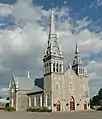 Saint-Charles-Borromée church built between 1839 and 1842 according to the plans of architect Thomas Baillairgé.
Saint-Charles-Borromée church built between 1839 and 1842 according to the plans of architect Thomas Baillairgé. Old presbytery built between 1815 and 1818.
Old presbytery built between 1815 and 1818. Water mill built in 1802 by Seigneur Joseph Chavigny de la Chevrotière.
Water mill built in 1802 by Seigneur Joseph Chavigny de la Chevrotière.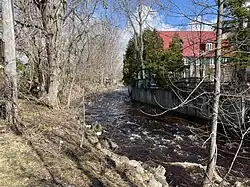 Rivière du Moulin and Vieux moulin Hamelin, Grondines
Rivière du Moulin and Vieux moulin Hamelin, Grondines Windmill, Grondines, St-Lawrence River
Windmill, Grondines, St-Lawrence River Grondines Wharf, St-Lawrence River
Grondines Wharf, St-Lawrence River Deschambault Wharf, St-Lawrence River
Deschambault Wharf, St-Lawrence River
References
- "Reference number 372307 in Banque de noms de lieux du Québec". toponymie.gouv.qc.ca (in French). Commission de toponymie du Québec.
- Ministère des Affaires municipales, des Régions et de l'Occupation du territoire – Répertoire des municipalités: Deschambault-Grondines Archived 25 June 2013 at the Wayback Machine
- Statistics Canada 2021 Census – Deschambault-Grondines census profile
- Ricard, Pierre-François. "Modifications aux municipalités du Québec, février 2002" (PDF). Direction de l’édition et des communications Institut de la statistique du Québec. Retrieved 21 May 2023.
- "Deschambault-Grondines". Commission de toponymie Québec. Banque de noms de lieux du Québec. Retrieved 21 May 2023.
- Saint Joseph at sqpn.ocm Retrieved 5 April 2013
- "Deschambault, a village of sailors". Le Soleil (French newspaper). Retrieved 29 April 2023.
- municipalité de Saint-Casimir, Historique
- Fonds D'archives des Seigneuries Sainte-Anne-de-la-Pérade et des Grondines ( 87P )
- Conversion lieue carré en Acre
- Item P209 - Acte de concession par Louis de Buade, Comte de Frontenac, et Jean Bochart Champigny, gouverneur et intendant de la Nouvelle-France, au sieur Louis Hamelin, seigneur en partie des Grondines, Archives Canada, Réseau Canadien d'Information Archivistique, BAnQ Québec, Fonds Intendants, Registres d'intendance.
- Le régime seigneurial au Québec 150 ans après, page 51
- Tables Généalogiques de la Noblesse Québécoise du XVII au XIX siècle
- Histoire Généalogique de la Famille Denys
- Histoire Généalogique de la Noblesse de la Nouvelle France
- Roy, Pierre-Georges (1916). La famille de Chavigny de la Chevrotière, Lévis, Québec, Monographies, Canadiana, p. 20-23-26-27-34-40-64-70-152-153-162
- Archives de la Province de Quebec, Lettres de Noblesse, Genealogies, Erections de Comtes et Baronnies, insinuees par le Conseil Souverain de la Nouvelle-France, page 113-116
- Études généalogiques et historiques sur la noblesse canadienne, page 12
- Dictionnaire biographique du Canada, Hamelin de Bourgchemin et de L’Hermitière, Jacques-François
- Deux officiers "indésirables" des troupes de la Marine
- La noblesse de France et du Canada, page 49
- "Grondines area, Geological report 154, p 12" (PDF). Ministry of Energy and Natural Resources (Quebec). Retrieved 29 April 2023.
- Nature Conservancy of Canada, The Grondines and Sainte-Anne-de-la-Pérade swamp, A unique ecosystem,
- "Deschambault-Grondines Climate". Canadian Climate Normals 1981–2010 (in English and French). Environment Canada. 31 October 2011. Retrieved 16 July 2015.
- Statistics Canada: 2006, 2011, 2016, 2021 census
- Répertoire du patrimoine culturel du Québec
Further reading
- Mariages de Deschambault (comté Portneuf) – 1713–1900, raised by Rosaire Proulx priest, compiled and published by Benoit Pontbriand agronomist, 1966, 213 pages (in French)
External links
![]() Media related to Deschambault-Grondines at Wikimedia Commons
Media related to Deschambault-Grondines at Wikimedia Commons